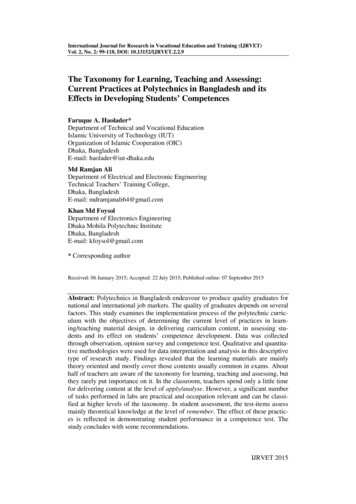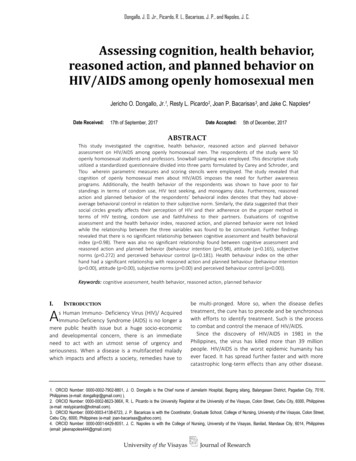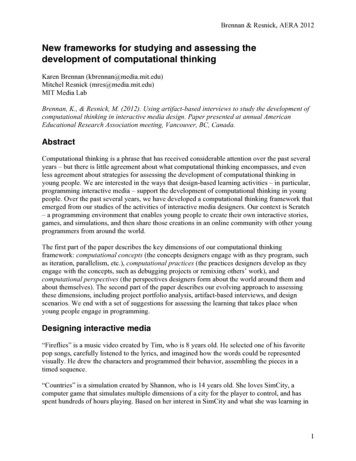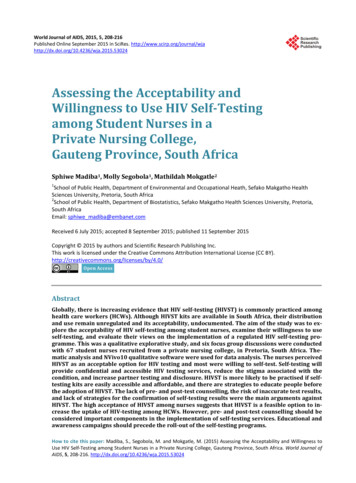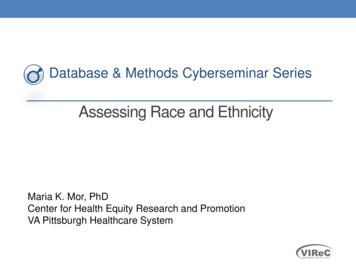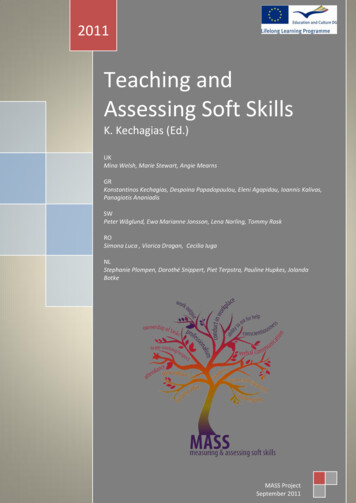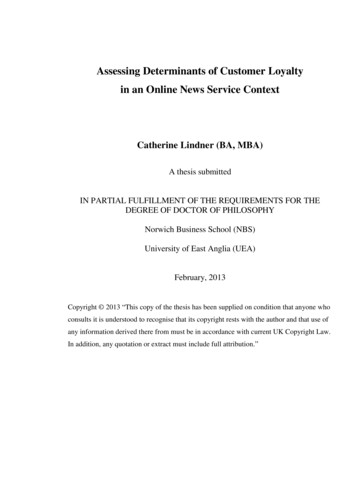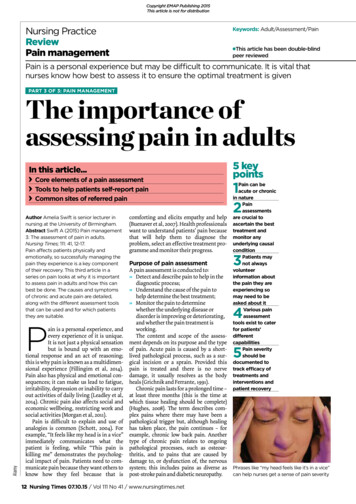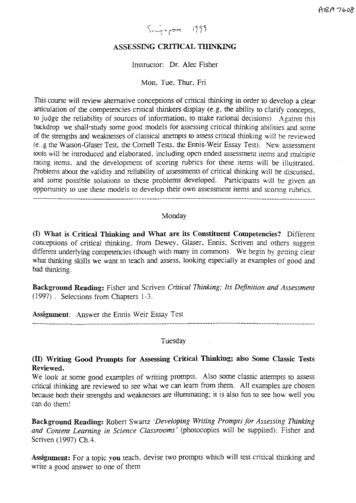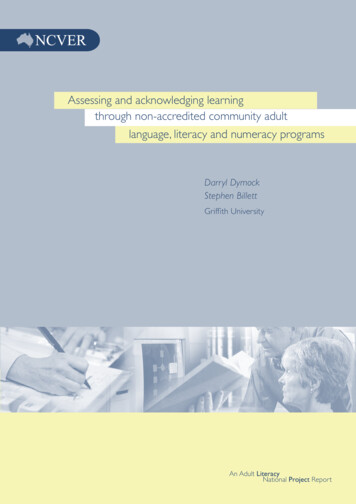
Transcription
Assessing and acknowledging learningthrough non-accredited community adultlanguage, literacy and numeracy programsDarryl DymockStephen BillettGriffith UniversityAn Adult LiteracyNational Project Report
NCVERAssessing and acknowledginglearning through non-accreditedcommunity adult language,literacy and numeracy programsDarryl DymockStephen BillettGriffith UniversityThe views and opinions expressed in this document are those of the author/project teamand do not necessarily reflect the views of the Australian Government,state and territory governments or NCVER
Publisher’s noteAdditional information relating to this research is available in Assessing and acknowledging learningthrough non-accredited community adult language, literacy and numeracy programs: Support document. Itcan be accessed from NCVER’s website http://www.ncver.edu.au/publications/2021.html .To find other material of interest, search VOCED (the UNESCO/NCVER international database http://www.voced.edu.au ) using the following keywords: adult education, adult learning,assessment, community education, language, literacy, numeracy. Australian Government, 2008This work has been produced by the National Centre for Vocational Education Research(NCVER) on behalf of the Australian Government. Funding has been provided under the AdultLiteracy National Project by the Australian Government, through the Department of Education,Employment and Workplace Relations. Apart from any use permitted under the Copyright Act1968, no part of this publication may be reproduced by any process without written permission.Requests should be made to NCVER.The views and opinions expressed in this document are those of the author/project team and donot necessarily reflect the views of the Australian Government or NCVER.The author/project team was funded to undertake this research via a grant. These grants areawarded to organisations through a competitive process, in which NCVER does not participate.ISBNISBN978 1 921412 49 3 print edition978 1 921412 50 9 web editionTD/TNC 93.03Published by NCVERABN 87 007 967 311Level 11, 33 King William Street, Adelaide SA 5000PO Box 8288 Station Arcade, Adelaide SA 5000, Australiaph 61 8 8230 8400 fax 61 8 8212 3436email ncver@ncver.edu.au http://www.ncver.edu.au http://www.ncver.edu.au/publications/2021.html
About the researchNCVERAssessing and acknowledging learning through non-accredited communityadult language, literacy and numeracy programsby Darryl Dymock and Stephen Billett, Griffith UniversityBeyond the obvious acquisition of the three ‘R’s’—reading, writing and arithmetic—many other benefitsderive from learning. Increases in self-esteem and confidence have often been cited as consistent, ifunanticipated, outcomes of learning and have been achieved even when there has been limited gain inthe competency being learned. Further, such confidence-building can have a positive impact on how andwhat an individual learns. While the measurement of objective competencies acquired through learningis well developed, the measurement of the wider benefits of learning is still in its infancy.This report by Darryl Dymock and Stephen Billett identifies the extent to which indicators might bedeveloped for a range of learning outcomes in non-accredited community adult language, literacy andnumeracy programs. It follows Dymock’s earlier work, Community adult language, literacy and numeracyprovision in Australia (NCVER, 2007), which attempted to gauge the extent of provision of this type oftraining in Australia.Key messagesß It is possible to assess the wider benefits of non-accredited adult language, literacy and numeracylearning. However, different types of assessment instruments, which cater for the diversity andcomplexity of learners’ needs, motivations and outcomes, are necessary. Special attention must bepaid to the language adopted in the instruments so that these can be easily used by tutors andtheir students.ß Both learners and tutors derive personal and educational outcomes by participating in the processof assessing and acknowledging learning outcomes.ß Tutors in this field, many of whom are volunteers, are in need of professional development to fullyunderstand the purpose and language of the assessment instruments.ß The right approach to assessment can build the self-confidence of students, many of whom are notsuited to formal education settings.Tom KarmelManaging Director, NCVERInforming policy and practice in Australia’s training system
AcknowledgementsFrom the start this was a collaborative project and we would like to thank the six people from thepartner organisations who contributed so much of their time and intellect to it throughout 2007:Debbie Jeanes, Adult Literacy Coordinator, Aberfoyle Community Centre, South Australia;Jacinta Agostinelli, Adult Literacy Coordinator, Glenroy Neighbourhood Learning Centre, Victoria;John Pryer, Coordinator, Hackham West Community Centre, South Australia; Tamara Angus,Team Leader, Community Learning, Pine Rivers Neighbourhood Centre, Lawnton, Queensland;Marcia Barclay, Manager, and Pamela Thurbon, Coordinator of Operations, Read Write Now!,Western Australia.Behind them were the numerous learners, teachers, and volunteer tutors and coordinators in thenon-accredited language, literacy and numeracy programs in four states who so willinglycontributed to the discussion on the extent to which it was possible to identify ‘wider learningoutcomes’ and to selecting the instruments to be trialled. Thank you all for your input, yourcriticisms, and for making sure we kept the research well grounded in practice. Special thanks toLiz Hughes in Northam, Western Australia, and Ellen Jezierski at Aberfoyle Community Centrefor additional support, and to Miki Petrusic at Overload Solutions for excellent transcription ofthe interviews.Darryl Dymock and Stephen BillettGriffith University4Assessing and acknowledging learning through non-accredited community adult LLN programs
ContentsTables6Executive gy12Findings14Review of research14Collaborative identification of potential instruments16Trialling the instruments19Discussion21Purposes and processes of assessment21Other issues24Research questions25Conclusion27References28Appendices1 Cover email letter to partner organisations with trial instruments292 Trial instruments for monitoring progress313 Modified Trial Instrument E39Support document detailsNCVER415
Tables61Interviews and other data sources, by partner and category132Development of working portfolio of instruments173Choice of trial instruments at each site194Factors associated with the process of assessment215Factors associated with outcomes of assessment24Assessing and acknowledging learning through non-accredited community adult LLN programs
Executive summaryPurposeThis research explores the potential for developing instruments that assess and acknowledge thewider benefits of learning for adults participating in non-accredited community language, literacyand numeracy programs. The extent and variety of the learning needs and motivations ofparticipants in these programs are not yet sufficiently accounted for in other assessmentframeworks, such as the National Reporting System (NRS).1 Therefore, it is necessary to identifyapproaches and procedures for assessing and acknowledging the outcomes that participants achievein these courses. For this study, ‘non-accredited’ learning is that for which no nationally accreditedvocational education and training (VET) qualification is awarded to learners.ApproachesThe research comprised three stages. Firstly, a review of national and international research wasundertaken to map the wider benefits of learning that have been identified in non-accredited adultlearning. This review was augmented by an analysis of data collected in a 2006 study that mappedthe provision of non-accredited community learning in adult language, literacy and numeracy inAustralia (Dymock 2007a).Secondly, following that review, a number of potential assessment instruments that could be usedto assess and acknowledge the outcomes of learners in non-accredited adult language, literacy andnumeracy programs were identified by the authors. Through collaboration with five researchpartners, six of these instruments were selected as being most appropriate for these purposes.2 Theresearch partners were community education providers in Queensland, Victoria, South Australiaand Western Australia and were selected for reasons of diversity in user groups and locations.Thirdly, the selected instruments were trialled and evaluated in the field at the partner sites. Afterthe trial period, partner representatives reported on their experiences in using the instruments toassess and acknowledge wider learning outcomes in non-accredited adult language, literacy andnumeracy.12The National Reporting System (NRS) is a mechanism for reporting the outcomes of adult English language, literacyand numeracy provision in the VET system in labour market programs and in the adult and community education(ACE) sector. The National Reporting System takes into account the complexity of language, literacy and numeracycompetence, considering not just competence with linguistic and mathematical systems, but also the ability to shapelanguage and numeracy use according to purposes and contexts. The National Reporting System has been recentlyreviewed. It will be known as the Australian Core Skills Framework and will be released in late 2008.The selected instruments were: (i) Changes in confidence; (ii) Learner outcomes: personal, social, economic; (iii)Individual learner profile; (iv) Learner indicators of success; (v) Criteria for achievement; (vi) Skills and wider outcomes.Each of instruments (i) to (v) was based on existing measures and adapted by the participating research partners to suitlocal needs. Instrument (vi) is a composite instrument developed by the authors from their review of research and theinterview responses. The ‘Findings’ section provides further information on each of the selected instruments. A copyof each instrument can be found in appendix 2.NCVER7
FindingsAn understanding of the full extent of the learning arising through learners’ participation in nonaccredited language, literacy and numeracy programs takes account of the following key factors: thepurpose or motivation for learning; the processes of assessment, if it occurs at all; and thecompetence of voluntary tutors. As a result, the study found that a range of instruments andapproaches would probably be required to assess and acknowledge learning outcomes that arespecific to particular learners or cohorts of learners.Diverse needsPeople who participate in these programs range from learners with significant disabilities, to thosewhose language development has never been fully realised, through to those developing theirlanguage competence because of social, family or work-related necessity. Other reasons forparticipating include changes in attitudes and wanting to develop a greater sense of self andpersonal competence (that is, being confident enough to accept new challenges). Such diversity oflearner and learning goals warrants assessment processes commensurate with these goals.Diverse outcomesFrom the review of literature the research identified seven categories of ‘wider benefits’ of learning.These were: self-confidence; engagement with others; attitudes to learning; agency/pro-activity(actively learning through experience); life trajectories; personal growth; and social capital. Thisstudy confirmed those categories and the importance of acknowledging the wider benefits oflearning. In general, these benefits include enhanced personal confidence, heightened socialcompetence, and the opening-up of possibilities and prospects that were not options prior toparticipation in these programs. Outcomes such as these are not the focus of or are captured inaccredited learning frameworks like the National Reporting System. Importantly, the findings ofthis review also pointed to the development of a ‘learning identity’ as a key element of engagementin the learning process, a concept that needs further research.Diverse kinds of instrumentsGiven the diversity of learner outcomes arising from non-accredited language, literacy andnumeracy programs, the approaches to assessment need to be correspondingly diverse to ensurethat the wider benefits of learning are captured. In the practical component of the research, all sixinstruments were used to some effect in different teaching and learning contexts. However, nosingle instrument was identified as being the most preferred across all sites. Instead, each of theinstruments in different ways had particular qualities and uses, which underlined that theseassessment processes are likely to require a range of instruments and usages.The instruments were most useful when the level of language used to capture the learning was easyfor the learners to understand—or at least for the tutors to interpret for them. Moreover, therelative value given to each of the wider benefits will vary at a local level, and, consequently, so willthe choice of indicators. A ‘portfolio’ of instruments is therefore likely to be necessary to addressdiversity in learners’ and tutors’ needs. In other words, greater consideration needs to be given tothe processes involved in assessing and acknowledging learner outcomes. The simple adoption ofuniform measures is unlikely to prove satisfactory or be appropriate.How such instruments are used instead of or in conjunction with existing frameworks is a decisionfor those responsible for the programs, but their administration has the potential to be particularlyuseful in formative as well as summative learner assessment. External reporting (for example, tomanagement or a funding body) may best be done through the aggregation of individualassessments of outcomes, the nature of th
2 T he s el ctd inru ms w : ( ) C ag n of d ; L r p , Individual learner profile; (iv) Learner indicators of success; (v) Criteria for achievement; (vi) Skills and wider outcomes. Each of instruments (i) to (v) was based on existing measures and adapted by the participating research partners to suit local needs. Instrument (vi) is a composite .
